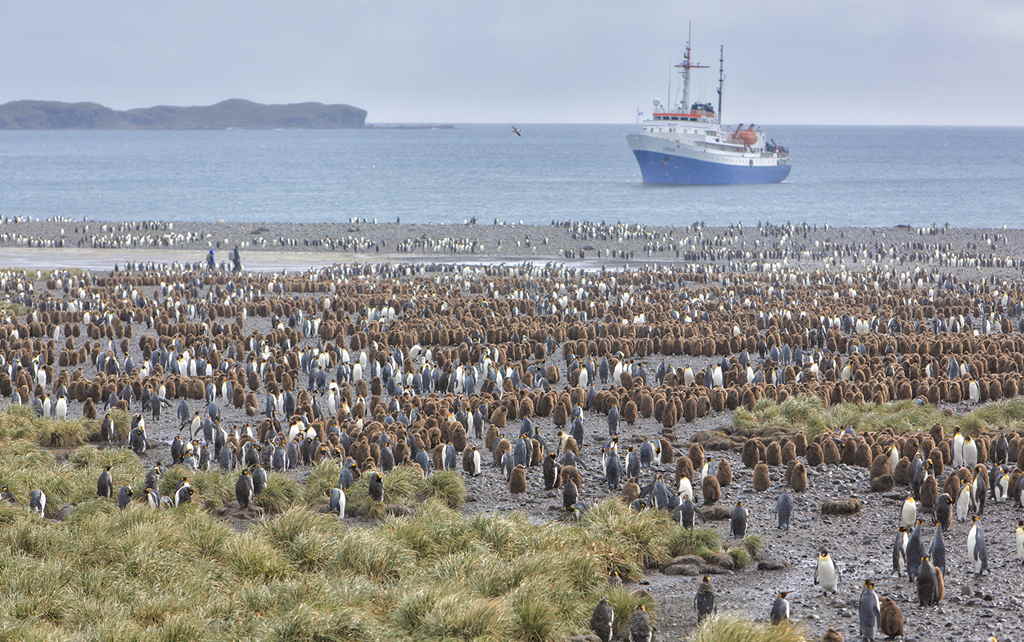Enveloped in white, the scenic Antarctica is not sparse but a treasure trove for wildlife and nature lovers. It boasts of several species of animals and birds and breath-taking sceneries. Capturing them are 45 mesmerising colour pictures by Dr. Ajit K. Huilgol at the ongoing virtual exhibition “Antarctica – The Last Frontier”.
Organised by India International Centre the show is on till March 14.
Despite being labelled biased it is the penguins who catch your immediate attention. Playful, photogenic and colourful, they win your heart! Huilgol snapped seven different species but only five are on view. These are Gentoo penguin, Rockhopper penguin, Adelie penguin, Chinstrap penguin and King penguin. “Of these, the King Penguin is the most colourful, especially their neck feathers,” he says.

Adelie penguin hopping
These wingless avian are hardly scared of human presence, looking straight into the camera. “All the species are so unafraid of humans and walk up really close to look at our shoes, peer into our lenses, and just hang around these strange creatures, as they must surely consider us!”
He quips, “we were all instructed to stay at least two metres away in order not to disturb them as they went about their business, but the penguins had obviously not been so instructed!”

Guard of honour
Huilgol has fond memories of his remarkable trip. Talking about the “King penguin colony” image, he says, “Their colony had about 250,000 pairs of breeding penguins. While all the chicks were dirty brown colour, the parents were so colourful. There was a feeding frenzy all around, with the parent penguins feeding fish to the chicks, regurgitating the fish they had caught at sea.”
Even though Antarctica is thinly populated, the human imprint is prominent. Capturing one is the “Abandoned whaling station”. What must have been buzzing with activity today stands desolate and forlorn!

Abandoned whaling station
“South Georgia, a small island off the coast of Argentina, is home to more than a million penguins and other birds and mammals. This island attained notoriety in the early to mid-90s as whaling harbour. Whales and seals were slaughtered in the thousands and millions to obtain lubricants from the blubber under their skins. These oils were essential in lubricating the moving engine parts that were the backbone of the Great Industrial Revolution in Europe and the US. Whaling has now been given up, and the ships and buildings of those years are now rusting away,” tells Huilgol.
Standing tall and big in comparison to the penguins are the albatross. The show has images of Black-browed albatross, though Huilgol had clicked the Wandering and the Light-mantled Sooty. The Wandering has the largest wingspan of 11 feet from wing tip to wing tip.

Black-browed albatross
“The prettiest of them all is the Black-browed. There was a large breeding colony of the latter in the Falklands, a tiny archipelago just off the coast of Argentina. The black brow adds a touch of magic to their eyes.” Adding a riveting bit of information, he says, “albatrosses come ashore only once in one to two years to breed! The rest of the time is spent in the air, flying, or at sea!”
Shining in solitary splendour in the exhibition, is the “Striated caracara”, a bird of prey, as it glides effortlessly in air. “It is one of the few birds here that can fly! All penguins are flightless birds, as are some species of ducks! The caracara flies around looking for a meal, and when it sees one, it will land and wait for one of the parent penguin birds to leave their nests to go to sea in order to catch fish. As soon as the chick is left unattended, the caracara will swoop in,” explains Huilgol.

Striated caracara in flight
Making their presence felt — by its sheer size and weight — are pictures of seals. Though there are several species in Antarctica, there are three for the viewers to see — Southern Elephant Seal, Antarctic fur seal, and Weddell seal.
“The first is the largest, with the largest recorded being about 22 feet in length, and weighing four tonnes (4000 kg), making it next to the elephant in size, and bigger than the rhino or the hippo!” observes Huilgol.
Look for the “Weddell seal yoga pose” image that steals the show, as you feel the mammal is performing the act precisely for Huilgol to click!

Weddell seal yoga pose
The pictures of ships with the icebergs and mountains in the background make a telling statement. Concurring, he remarks, “On photographing them I realised how infinitesimally tiny and puny and powerless we are, and to give the viewer a sense of this, I took some images showing the ship next to the mountains and icebergs that towered over it.”
Talking about his treasured moments of the trip, Huilgol narrates a rather unique experience! “I broke off a chunk of an iceberg and took it back to the ship. When I added a small bit of it to my scotch, the air inside the ice made popping sounds as the ice melted. It then struck me that I was now breathing air that had been trapped inside that iceberg for 1000- 2000 years! Just that divine experience was worth more than I had spent on the journey!”




















